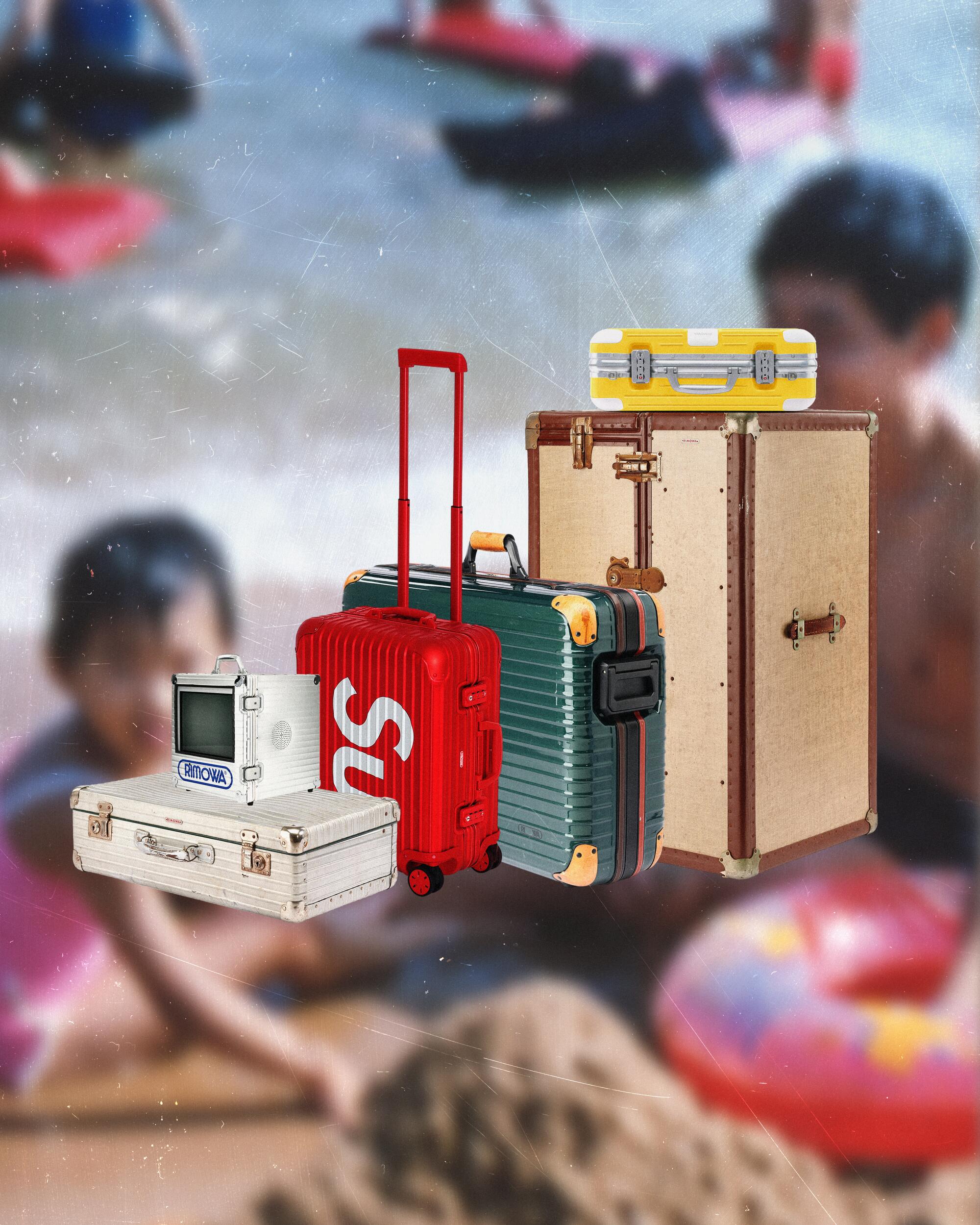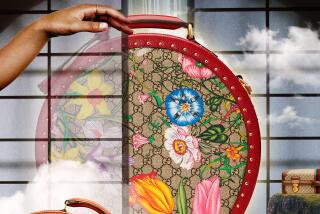- Share via

This story is part of Image’s April issue, exploring movement and how it changes us from within.
The sight of a suitcase has historically inspired dread in me. I grew up moving every few years with my family, so suitcases were ugly reminders of the moves ahead for us. And the suitcases themselves were ugly: padded with textured black fabric, soft on one side, hard on the other, the malleable side bumpy and uneven with toiletries that had been stuffed in at the last moment. Zippers would get stuck, the neon bows (tied on the handles) dirty. One suitcase handle would only slide all the way up if I slid it up and down three times. Another had a chipped wheel that tumbled behind me like a difficult child at the airport.
Travel, unless you are extraordinarily wealthy or particularly deft at using points and mileage, is the inner circle of hell. In recent years I’ve given in to the traps of airlines — paying extra when I can to select my seat, for those two extra inches of legroom. But my largest indulgence by far has been my Rimowa, the luxury German suitcase. When I open it to pack, it offers two neat halves (each an actual half, not one taken up by a thick jutting rod). Placing clothes inside it is satisfying, like layering a mille-feuille cake. At the airport, it is a suitcase that pirouettes by my side as if we’re gliding over ice. The wheels, which were patented in 2001, smoothly rotate a complete 360 degrees — modeled after the wheels on office chairs and hospital beds, so that they can move with ease under weight. There are none quite like them.
Rimowa (pronounced Rimova) claims a lot of firsts, including the first polycarbonate suitcase, which it launched in 2000. Now common in the luggage industry, the material is light and easy to clean. In 2009, Rimowa launched the Salsa Air — the edition I own — which weighs 26% less than its parent collection. It lifts some of the burden of travel, so that you can psychically inhabit the remarkable reality of flight.
The company, which was founded in Cologne, Germany, in 1898, has seen several evolutions in its designs, with suitcases made of leather, wood, aluminum and vulcanized fiber. Luggage in the first half of the 20th century was much weightier and bulkier, designed for people with the means to have helpers carry their luggage for them. That all changed once travel became more accessible.
For Rimowa, the choice to make something durable and lightweight came from another incentive too: In the 1930s, a factory fire is said to have burned everything to the ground except for the aluminum, which inspired the brand to lean into the material and develop its signature hard-shell look, ribbed like the design of the first all-metal airplane (and resistant not only to fires but to perilous airport journeys).
Even though the brand has been around for 127 years, it wasn’t until 2016, when it was acquired by LVMH, that it became more widely known in the U.S. Now it is a highly coveted piece of luggage and fashion — a 125th-anniversary Rimowa exhibition boasted the personal suitcases of Spike Lee, Martha Stewart, Billie Eilish and Patti Smith, among others. Rick Owens has called his Rimowas “a constant fixture in my life, like a phone or a toilet — they’re essential.”
Earlier this year, Owens designed a suitcase for the brand with a bronzed exterior that required handmade pigment, making each suitcase unique. The edition joins a series of artist collaborations that sound similarly impossible and exacting, including the Supreme luggage that was made from 200-plus pieces, and the Alex Israel luggage that blushes like an L.A. sunset, a gentle gradient that required anodized aluminum. “It’s like putting a tattoo on aluminum,” as Rimowa puts it.


The Rimowas seem to say: Here, finally, is the suitcase that not only contains your life but is an extension of it. Here, finally, is a suitcase that will be your armor — and promises to look good in the process.
There is, in fact, a family of a Rimowas living in the closet under my staircase: one that is large and baby blue, another that is medium and deep blue, and two carry-ons, one lime green and the other bright purple. I could explain the collection by saying that my parents lived in Germany for two years, but in truth the story begins earlier.
“Cheap ends up being expensive” is my mother’s motto. In other words, cheap things don’t last — you end up buying multiple mediocre things when you could have just bought the one expensive thing that lasts. This was the rationale she applied to Rimowas, which range anywhere between $700 and $3,300 (special editions aside).
The brand wants your Rimowa to last. As of 2022, it now offers to fix any damaged part for free, for life. Though anything going wrong, Rimowa suggests, is rare and most importantly, not its fault.
My first Rimowa took a wrong turn.
It was the large baby blue one, which my mother purchased in Rio de Janeiro after my sister got married and had too many gifts to carry with her back home to New York. I reluctantly became her mule, my mother explaining to my 25-year-old self: This is a nice suitcase. Treat it well.
In this town, actors often stay at hotels for transient periods of time. But what is it actually like?
Three years later, I packed 10 years’ worth of my life in New York City into the suitcase and moved across the country to L.A. to be with my boyfriend. Days into our temporary sublet, we discovered it was infested with bed bugs. In a panic, I threw away my Doc Martens, my fabric carry-on and my Everlane backpack. But I couldn’t get rid of the Rimowa — even though it had likely become a bed bug nest. Besides being too expensive for the trash, it had developed the veneer of a family heirloom. My boyfriend and I agreed we could wrap the “BB bag” in eight heavy-duty black trash bags and store it until we felt the bugs were safely dead.
One year later, our trauma not subsiding, we decided to keep the phantom bugs starving in the BB bag and buy another Rimowa. I chose a medium size, one that was large enough for any trip. Well, almost any trip. It seemed my Rimowas were destined to transport goods for my family. My parents, now retired in Brazil, had me bring various things from L.A.: headphones, soft toothbrushes, hair dryers, sleeping pills, heating pads, slippers, nasal sprays, art books, cashmere sweaters. By the time I was done packing, there was no more room for my clothes. “I’m bringing you America!” I exclaimed. And then somehow, I brought back Brazil, or rather all of my mother’s closet. The solution to one Rimowa not fitting it all? Have another Rimowa, and then another. (My parents benevolently gave me their carry-ons — they’d buy others.)
The notion that we were saving in the long term no longer seemed defensible. It wasn’t ever really the point.
Rimowas are built not only to last but to survive. There’s the suitcase that remained intact after a plane crash, and another that came through a tornado. One was built especially for a violinist after he slipped postconcert and his million-dollar instrument got destroyed. Your clothes, your professional camera, your bar set, your trumpet, your DJ records — they’re all safe within these tried-and-true shells. “Guaranteed for a lifetime of memories” is the brand’s new motto.
But for Rimowa, lasting does not mean looking as good as new. In a video that offers the delusion that travel is as calming as the piano on the soundtrack, hands open and close Rimowas that are embraced for the imperfection that comes with use: “Every dent, scratch and sticker is a memory.” I try to feel as inspired by the dent in my medium-sized Rimowa and the small tear that has opened in the mesh. My cynical side thinks this is the brand’s way of manipulating how we feel about our suitcases gradually breaking down. It is true that, unlike suitcases past, when I look at my Rimowas, they bring me memories rather than pure dread — even, yes, the BB bag.
Ten months ago, my boyfriend and I decided that after six years, it was time to remove the BB bag from purgatory. Nervous, we ripped through the eight layers. Underneath, the suitcase awaited, a memento from my rough landing in L.A. Somehow, we’d come out the other end, bright and bug-free.











